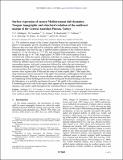Surface expression of eastern Mediterranean slab dynamics: Neogene topographic and structural evolution of the southwest margin of the Central Anatolian Plateau, Turkey
Author(s)
Schildgen, T. F.; Cosentino, D.; Caruso, A.; Buchwaldt, Robert; Yildirim, C.; Bowring, Samuel A.; Rojay, B.; Echtler, H.; Strecker, M. R.; ... Show more Show less
DownloadBowring_Surface expression.pdf (5.822Mb)
PUBLISHER_POLICY
Publisher Policy
Article is made available in accordance with the publisher's policy and may be subject to US copyright law. Please refer to the publisher's site for terms of use.
Terms of use
Metadata
Show full item recordAbstract
he southwest margin of the Central Anatolian Plateau has experienced multiple phases of topographic growth, including the formation of localized highs prior to the Late Miocene that were later affected by wholesale uplift of the plateau margin. Our new biostratigraphic data limit the age of uplifted marine sediments at the southwest plateau margin at 1.5 km elevation to <7.17 Ma, and regional lithostratigraphic correlations imply that the age is <6.7 Ma. Single-grain CA-TIMS U-Pb zircon analyses from a reworked ash within the marine sediments yield dates as young as 10.6 Ma, indicating a maximum age that is consistent with the biostratigraphy. Our structural measurements within the uplifted region and fault inversion modeling agree with previous findings in surrounding regions, with early contraction followed by strike-slip and extensional deformation during uplift. Focal mechanisms from shallow earthquakes show that the extensional phase has continued to the present. Broad similarities in the change in the tectonic stress regime (after 8 Ma) and the onset of surface uplift (after 7 Ma) imply that deep-seated process(es) caused post-7 Ma uplift. The geometry of lithospheric slabs beneath the plateau margin, Pliocene to recent alkaline volcanism, and the uplift pattern with accompanying normal faulting point toward slab tearing and localized heating at the base of the lithosphere as a probable mechanism for post-7 Ma uplift of the southwest margin. Considering previous work in the region, there appears to be an important link between slab dynamics and surface uplift throughout the Anatolian Plateau's southern margin.
Date issued
2012-03Department
Massachusetts Institute of Technology. Department of Earth, Atmospheric, and Planetary SciencesJournal
Tectonics
Publisher
American Geophysical Union (AGU)
Citation
Schildgen, T. F. et al. “Surface Expression of Eastern Mediterranean Slab Dynamics: Neogene Topographic and Structural Evolution of the Southwest Margin of the Central Anatolian Plateau, Turkey.” Tectonics 31.2 (2012). Copyright 2012 by the American Geophysical Union
Version: Final published version
ISSN
0278-7407